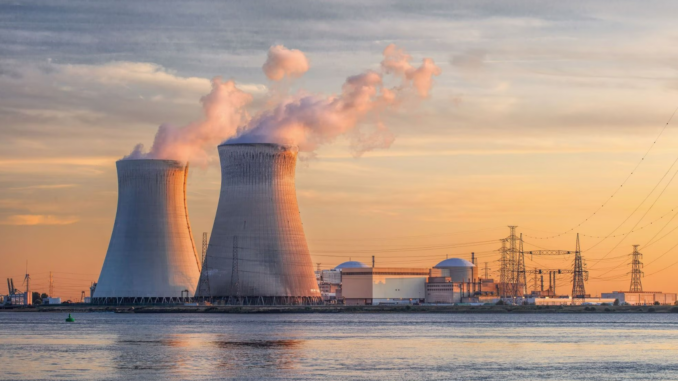
A new Citi Research report from a team led by Arkady Gevorkyan looks at trends in nuclear energy and how the next decade looms as a pivotal point for global growth.
Nuclear energy, one the largest low-carbon sources of electricity, is poised for global growth thanks to such drivers as the potential acceleration of new technologies, net zero aspirations and the importance of low-carbon sources of power. While we’ve observed different trends between developed-markets and emerging-markets economies, the majority of countries are considering keeping or expanding nuclear energy in their energy mixes.
Why do we see the next decade as pivotal for nuclear energy’s prospects? One reason is that small modular reactors (SMRs) and advanced reactors (ARs) are set to shape the technology’s future, sealing its role in the energy transition and the broader energy mix. As SMRs are getting ready to be scaled, new factors could influence nuclear energy’s future in the U.S., including coal-to-nuclear switching, the demand growth for data centers driven by AI, and serving distant areas for oil & gas exploration. Such discussions are notable because the U.S.’s 95 operational nuclear reactors are the highest number globally, and nuclear energy represents close to 20% of its broader energy mix.
In our base and bull scenarios, global nuclear-energy capacity will experience meaningful growth between now and 2050. At the COP28 climate-change conference, more than 20 countries committed to tripling their nuclear capacity by that date. (Projections are for nuclear-energy capacity in the U.S. to increase 12%.)

The International Energy Agency sees nuclear-energy generation hitting record highs in the next few years. An additional 29 Gigawatts of new nuclear capacity is expected to come online globally, while existing nuclear plants continue to seek lifetime extensions. In the U.S., we don’t expect forced retirements of nuclear plants anytime soon. We do estimate that generation by nuclear energy in the U.S. could see slightly longer down time in the second half of this year due to a number of plants’ refuelment schedules, and such down time could drive more demand for other energy sources. (Historically, gas and coal have filled the gap.)
To forecast nuclear generation, we’ve developed a robust machine-learning algorithm using a 10-year training period of historical generation data and looking two years ahead. We include outages associated with the refuelment cycle and control for the length of those outages. The accuracy ratio for an out-of-sample two-year period is at 94%. Uranium demand also correlates closely with that schedule, as utilities typically need to procure uranium at least two years in advance of a refuelment period.
An industry rejuvenation?
Nuclear energy’s development in the U.S. could contribute to global appreciation and adoption of it. At the moment, U.S. discussions of nuclear energy range across a number of topics, which we explore in greater detail in the report.
The past six to 12 months have seen a number of license-renewal applications to the Nuclear Regulatory Commission seeking lifetime extensions for reactors. As a result of such extensions, we project uranium demand will be higher by 3 million pounds in 2030, 13 million pounds in 2040, and 17 million pounds in 2050 — projections that don’t include potential new builds. On average, we estimate, close to 50 million pounds of U308 is consumed annually in the U.S.
The U.S. Department of Energy (DOE) has made a conditional commitment to provide $1.5 billion to reactivate the Palisades nuclear plant, marking the first nuclear-plant restart in the U.S. and setting a precedent. We’ve included Palisades in our 2028–2029 balances for fuel procurement, given its potential restart date of 2030. And there are ongoing discussions about restarting the Three Mile Island Nuclear Generating Station.
The DOE has also advocated for converting retiring coal planets to use nuclear energy, which would require about 200 Gigawatts electric of nuclear capacity, with SMRs seen as playing a key technological role. But we note caveats: The timing on rolling out SMRs must match up with the coal-plant retirements, and an adequate, trained labor force is needed to operate the SMRs.
There are additional nuclear-energy demand factors to consider in pondering nuclear energy’s future, including data centers/AI, the oil upstream sector and space exploration. Use cases for SMRs are gaining traction, with the U.S. an extremely attractive market for baseload power.
The U.S. remains a hotbed for SMR development, with supportive policies and available funding. We think SMRs could represent up to 15% of global uranium demand by 2040. We see the possibility that three SMRs could be connected to the grid by 2034, with another five or six connections in the U.S. alone after that. But we also note that nuclear projects, including SMRs, require significant upfront investment. Costs are high due to technological complexity, stringent safety requirements and the need for specialized materials and skilled labor. While the DOE estimates the first-of-a-kind cost of a well-executed nuclear project at ~$6,200 per kilowatt, recent nuclear construction projects in the U.S. have had overnight capital costs of more than $10,000 per kilowatt. That said, subsequent deployments are expected to benefit from technology learning, supply-chain maturity and manufacturing improvements. Those could drive down capital costs and unlock deployment at scale.
Securing financing is an additional challenge due to the history of nuclear projects’ cost overruns; the transition from large, monolithic infrastructure projects to modular ones may alleviate some uncertainty. Still, recent cost estimates for several SMR demonstration projects have increased more than 70% from initial estimates due to inflationary pressures, supply-chain constraints and evolving designs.

Other factors to consider in exploring nuclear-energy trends:
- Nuclear energy has bipartisan support, an exception to the norm during a U.S. election year.
- We forecast AI/data-center growth to increase U.S. total power demand by ~456 Terawatt hours by 2030, the equivalent of ~11% of total U.S. power generation. While we see near-term generation additions coming from gas plants, we also see incremental investment opportunities for the existing U.S. nuclear fleet. Due to nuclear plants’ seasonality and turnaround schedules, we assume data-center customers would prefer to collocate data centers with nuclear plants in a cluster for improved reliability and stability.
- The provisions of the Inflation Reduction Act (IRA) could help provide stability. The IRA established a production tax credit of $15 per Megawatt hour on electricity generated from nuclear facilities from 2024 through 2032. This serves as a structural price floor that could prevent downside loss in a volatile market. U.S. regulated utilities with nuclear assets are likely to receive production tax credits that gradually ramp from 2024 through 2027 before reversing in 2032.
- Long-duration contracts with data-center developers could receive premium pricing, with a recent Talen Energy-Amazon deal providing an example. Incremental power demand from AI/data centers and electrification could drive efforts to improve nuclear plants’ utilization and deliver incremental capacity uprates.
Take the Survey at https://survey.energynewsbeat.com/






